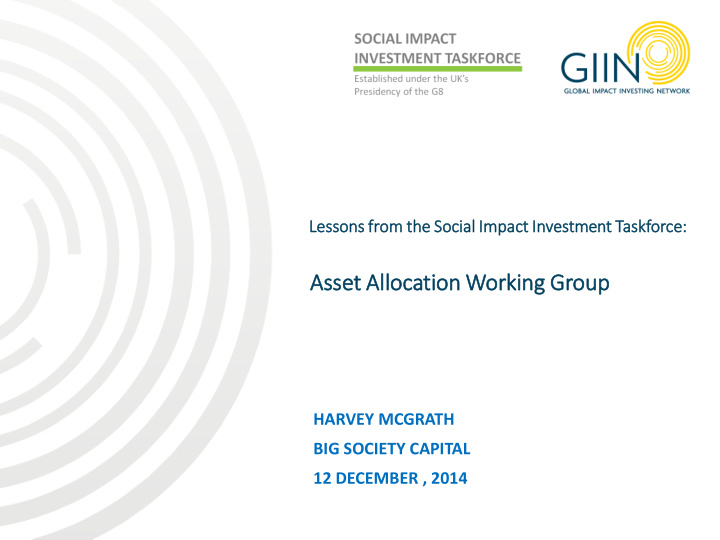



Less Lessons fr from om the he Soc Socia ial l Im Impa pact In Investment Task askforce: Ass sset Allo llocation Wor orking Gr Group HARVEY MCGRATH BIG SOCIETY CAPITAL 12 DECEMBER , 2014
Rationale Why should policymakers encourage Social Impact Investment? Policymaker benefits Incremental resources to address tough societal challenges: Increases financial capital to support/scale sustainable solutions to pressing social needs Increases human capital to drive greater innovation Encourages/enables policymakers to procure against measured outcomes, to share risk and to test and adapt interventions real-time Increases positive investment/business externalities Decreases negative investment/business externalities 2
How can Policymakers best encourage greater allocations? What are the key barriers to take-off? Asset Owners Intermediaries Identifying the most relevant ‘pools’ of Key Barriers capital Identifying the greatest barriers for each pool 3
The Challenge Constructing a key barrier matrix Asset Owners Intermediarie s Key barriers Conflict of Pension Funds | Duty Disproportionate transaction costs “Pension funds often have strict Mass retail | Capital risk rules about investment size, % “For retail, wealth is holding and management fees” Nascent generally for retirement Sector purposes or for the next Advisors | Exit risk generation, making capital “Flexibility to sell a preservation, at a security can be a key minimum, a priority” requirement for advisors considering whether to invest a client’s money” Risk Factors Foundations | Impact risk “For foundations, it is critical that impact performance is sufficiently cost-effective to justify diverting funds from existing ‘tried and tested’ investments that optimise surpluses for 4 grantmaking ”
A Solution 10 Policy Levers for Change Regulation levers Clarification Fiscal ‘Do or ‘Opt out’ as Priority incentives of fiduciary Explain’ standard sector duty rule package lending • Permit (and Introduce tax relief Require all Require all Require banking consider requiring) schemes which, regulated financial pension fund institutions to investors to factor depending on and charitable offerings to lend to priority social and local context, may organisations to include an sectors environmental target social articulate their allocation to social impacts into enterprises, contribution to impact investment investors in social social impact investment, unless decisions enterprises and/or investment a pensioner • Require reporting regulated social chooses to ‘opt on ESG factors investment funds out’ • Regulation 28, • CEDIFs programme, CSR Clause 135, FCPES offered as • Community • South Africa Canada India part of Reinvestment Act, • Brazilian Sustainable • Social Investment employees’ US Tax Relief, UK Stock Exchange ERISA legislation, savings plan, • RBI prescription, Initiative US France India 5
A Solution 10 Policy Levers for Change Participation levers Request for Bundling Catalytic Placement and Impact proposals capital distribution rating platforms system • Provide matching Challenge product Stimulate the Support platforms Support the capital, first loss developers to intermediary that showcase a development of layers positions, bring forward market (through wide range of an impact guarantees, tax opportunities with co-investment or social impact investment schemes and/or profiles that fund-of funds) to investment rating system, insurance commissioners/ create more products, allowing including a • Support asset owners are bundled/multi- investors to formal alliance enterprises / looking for asset products compare, with a credible products to at-scale benchmark and global rating become even trade agency investment-ready Investing4Growth Big Society • African Agricultural • SVX, Canada • Rating initiative, initiative, UK Capital, UK Capital Fund, Africa • IIX, Asia Luxembourg/ • Investment • GAX, Ghana Switzerland readiness fund, UK • GIIRS 6
Rationale Why should investors allocate to Social Impact Investment? Responsible investing Sustainable investing Social Impact investing Mitigating Environmental, Social and Governance (ESG) risks Pursuing Environmental, Social and Governance (ESG) opportunities Protects value due to Delivering measurable solutions May enhance value a wide consideration of to societal challenges due to investment ESG factors, often Increases options for • selection (choosing including negative asset owners seeking to investments with screening of harmful apply a values lens to positive ESG products their strategic asset behaviour/potential) allocation and active portfolio • May increase management, diversification within a including shareholder broader portfolio due to advocacy emergent return and correlation profile of some Social Impact investment categories, e.g. Social Impact Bonds • May enhance value by offering growth opportunities that the 7 market has overlooked
Context Our report described an emerging ‘Spectrum of Capital’ to help clarify the terms and position the choices available to investors. 8
Impact Allocation Matrix Impact investment in our view should be considered a strategy that can be applied across a variety of asset classes. This results in an Impact Allocation Matrix, as shown below. 9
Strategic Asset Allocation framework Based on a series of relatively conservative assumptions, we estimated that an investor with an 8 – 12% impact investment allocation should be able to achieve the same financial return as an investor with no impact allocation, assuming that the dedicated investor is willing to accept a larger share of the portfolio in illiquid investments. 10
Investor recommendations – next steps We now wish to take this impact allocation framework and ground it in the reality of today’s market, by writing a follow-on technical paper that illustrates the range of products available today within each ‘box’ on the Impact Allocation Matrix 11
Questions? Have thoughts or feedback? Email the GIIN: Lgustafson@thegiin.org Find the full working group report at www.socialimpactinvestment.org Find the other webinars in this series and further information on impact investing at www.thegiin.org
Recommend
More recommend